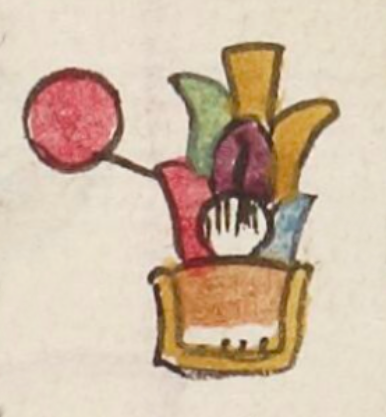Ce Acatl (TR14v)
This colorful notation combined with a simplex glyph stands for a date that serves as a personal name, One Reed (Ce Acatl). It comes from the Codex Telleriano-Remensis. The one is a round, red circle connected to the reed (acatl) by a black line. The reed, shown in a frontal view, is golden with leaves in gold, red, green, and blue. A purple/brown (eagle?) feather and a white down ball decorate the reed, reminding the viewer of the decorations for arrows. Typical of the acatl-as-date, the reed sits in a container. But this one is different from the norm. It is a golden container with light brown and white coloring and small black vertical lines at the base.
Stephanie Wood
This name is from the 260-day divinatory calendar called the tonalpohualli. Calendrics were an important element in the Nahuas' religious view of the cosmos.
Stephanie Wood
ca. 1550–1563
Jeff Haskett-Wood
dates, fechas, calendarios, reeds, canes, cañas, carrizos, 1-caña

ce, one, https://nahuatl.wired-humanities.org/content/ce
aca(tl), a reed or cane, https://nahuatl.wired-humanities.org/content/acatl
Uno Caña, 1-Caña
Stephanie Wood
Telleriano-Remensis Codex, folio 14 recto, MS Mexicain 385, Gallica digital collection, https://gallica.bnf.fr/ark:/12148/btv1b8458267s/f54.item.zoom
The non-commercial reuse of images from the Bibliothèque nationale de France is free as long as the user is in compliance with the legislation in force and provides the citation: “Source gallica.bnf.fr / Bibliothèque nationale de France” or “Source gallica.bnf.fr / BnF.”




